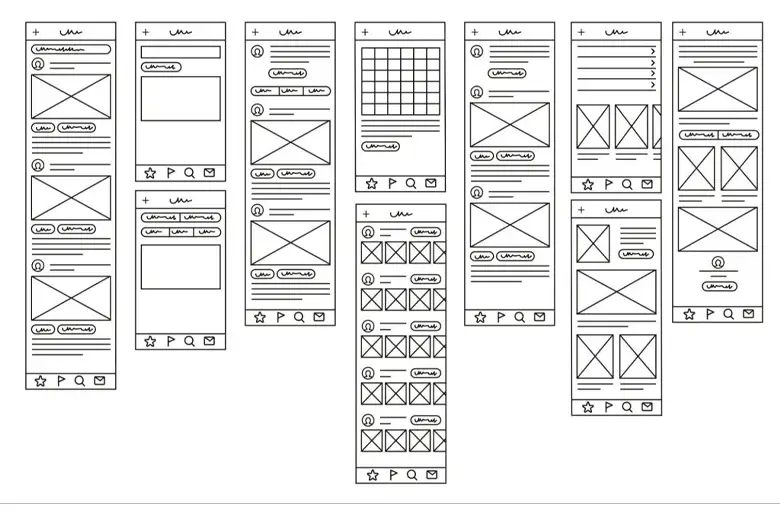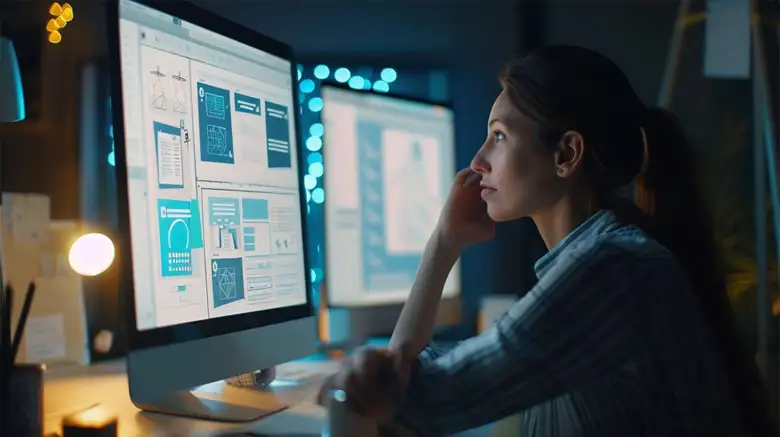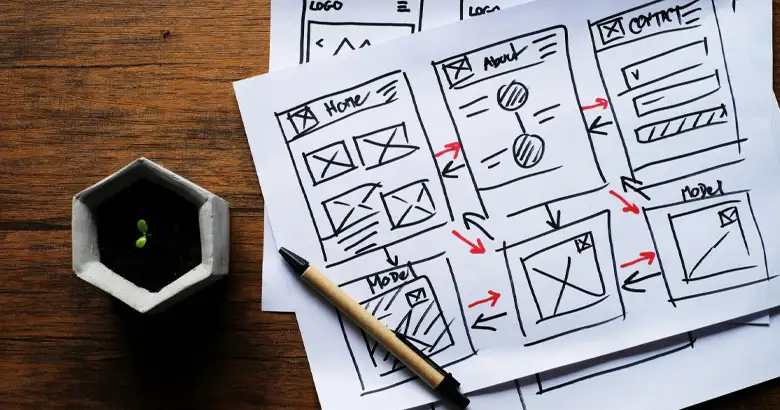Curious to know more about wireframing and prototyping and when to use each process? We’ve got all the answers here.
Wireframing and prototyping are crucial practices in the UX design process, enabling designers to test out their ideas, gather feedback, identify challenges, and communicate their vision for a project. However, although the two design methodologies have a lot in common, there are some fundamental differences in what they entail and how they are used.
If you’re looking for some clarity on how and when to use wireframes and prototypes, you are in the right place! In this article, we’ll be clarifying exactly what these two important processes do and what they can help you achieve. We’ll be offering definitions of wireframing and prototyping, diving into their essential differences, and walking you through the best tools for each methodology. Finally, we’ll be providing a rundown of mock-ups, their role in the UX design process, and where they sit between wireframing and prototyping.
Contents:
- What is wireframing?
- What is prototyping?
- What are the main differences between wireframing and prototyping?
- And what about mock-ups?
- Conclusion
Ready to get started? Then, let’s jump in.
What is wireframing?
Wireframing is the practice used by designers to create a visual guide or blueprint that communicates the desired structure and layout of a web page or app. The design focuses on the key components and content that help the design team convey how the website or app works and what the intended user experience of the interface is. In the UX design process, wireframing typically happens after user research has been conducted, and involves creating simple skeletal outlines using pen and paper or wireframing tools. Wireframing comes after user research to ensure that the designs are informed by the collected data and that they solve identified user challenges. The resulting wireframes highlight on-page functionality and the intended organization and hierarchy of design elements such as buttons and menus.
What does a wireframe look like?
Wireframes usually look like black-and-white sketches of the web page or app interface and include basic shapes such as squares or circles to represent buttons, text blocks, and images. Color and detailed graphics are not commonplace in wireframe sketches, with the designer’s focus instead being on the placement of content, the functionality of elements, and the hierarchy of components.
Text is used on wireframes primarily to label elements and provide short descriptions of how they are used. However, it is also sometimes used for:
- Headings and subheads that indicate content hierarchy
- Placeholder text to represent the placement of content
- Annotations to describe or explain specific functionality or behavior
Which tools are best for developing a wireframe?
While it’s commonplace for designers to sketch early-stage wireframes using just paper and a pen, for more complex designs there are numerous digital tools which can assist the process. Let’s take a look at some of the most popular wireframing tools.

1. Sketch
With its intuitive interface and numerous features, Sketch is a popular vector-based design software that is used for mockups, wireframes, and prototypes. A benefit of the software is how it supports designers in the creation and management of design systems and shared libraries, streamlining the wireframing process and ensuring consistency across different projects.
2. Adobe XD
Adobe XD is a powerful design tool with a broad range of robust features that support designers in sketching, prototyping, and sharing user experience designs for both web pages and apps. As part of the Adobe Creative Cloud suite, the tool integrates easily with other Adobe products like Photoshop, Illustrator, and After Effects, allowing for the importation of assets and seamless collaboration.
3. Figma
Supported by the cloud, Figma allows designers to work together in real-time on sketches, wireframes, and designs, enabling a fully collaborative design process. The software’s powerful vector network tool also enables the creation of complex shapes and layouts which further supports the wireframing process.
4. Balsamiq
Balsamiq offers designers a low-fidelity wireframe aesthetic that allows them to focus fully on layout, structure, and functionality when designing wireframes. The tool’s drag-and-drop interface is both user-friendly and easy to learn, which makes it accessible for experienced designers and design beginners alike.
5. Axure RP
Supporting the creation of detailed wireframes and interactive prototypes, Axure RP is the ideal tool for more complex projects that require additional features and functionality. The tool offers a library of pre-built widgets and components which speed up the wireframing process and ensure consistency across a design.
Why is wireframing important?
Wireframing provides significant value to designers and stakeholders as it helps them to visualize, plan, and communicate the structure and functionality of a proposed website or app in the beginning stages of the UX design process. Usability issues, such as unclear navigation or inaccessible features, can be identified and resolved early on, mitigating the need for costly revisions further down the line.
Wireframing also allows the team to experiment with different ideas in a low-fidelity, low-cost, and low-risk way, allowing collaboration and innovation to lead the design effort. Additionally, feature prioritization during wireframing benefits design teams, as the process creates opportunities for the team to try out different layouts and user flows until the ideal placement of contents and elements is found. Finally, a wireframe is a consistent guide for developers and designers to work from, serving as a reference point throughout a project for the whole team.
How and when to use a wireframe in the design process
Wireframes are usually sketched out fairly early on in the UX design process, shortly after an initial round of user research has been conducted by the design team. This is because the data and insights that have been gathered during the research phase inform and guide the initial sketches and ideas for the design.
Wireframes can also be used when gathering user feedback. Rather than creating interactive prototypes, a design team might instead choose to share early wireframe sketches with users to gauge the effectiveness of a design before investing more resources. Although users cannot interact with the design in the same way as a digital interface, they can still provide feedback on how effective they think the navigation or user flow of the website or app will be.
What is prototyping?
Prototypes are simplified versions of a website or app which effectively simulate its functionality, interactivity, and the user experience. The creation of these simulations is what’s known as prototyping. The purpose of a prototype is to give designers and developers an effective testing ground for new ideas, improvements, features, interactions, and workflows before the team commits to full-scale development.
While the term “prototyping” can sometimes be used interchangeably with “wireframing” and can refer to both basic sketches and interactive models, most designers understand prototyping to mean a more developed and interactive simulation of an app or website that effectively mimics the final product, as opposed to a static sketch.

What does a prototype look like?
The appearance of prototypes varies depending on its fidelity and the stage during which it is being used in the design process. Low-fidelity prototypes are similar to wireframes and are simple, hand-drawn or digital line sketches which are used to help a designer plan the navigation, user flow, or structure of a website or app. Medium-fidelity prototypes are usually more detailed and can include a simple color scheme, placeholder content, and basic interactions.
Finally, high-fidelity prototypes closely resemble the final website or app in how they look and how users interact with them. These prototypes include detailed graphics, color schemes, interactions, and typography, enabling design teams to conduct thorough user testing before sending the design to the development team for implementation.
Which tools are best for developing a prototype?
With interactivity and functionality at the heart of prototyping, UX designers require cutting-edge digital tools to bring their designs to life. Let’s take a look at some of the best software available to create clickable prototypes.
1. Figma
As well as being a popular tool for wireframing, Figma’s intuitive and user-friendly platform supports high-fidelity prototyping. The software offers robust prototyping features, enabling design teams to collaboratively create interactive prototypes that simulate real user interactions.
2. Invision Studio
Invision is recognized as a strong prototyping software due to its responsive design capabilities, comprehensive design environment, and interactive design features. The tool also supports handover to development, numerous plug-ins, and integration with user testing tools.
3. Flinto
With its vast range of animation, micro-interaction, and sharing capabilities, Flinto is often used by design teams when creating prototypes. The easy-to-use interface of the software further lends itself to the creation of quick, interactive prototypes without the need for excessive training.
4. Webflow
Webflow is a highly-regarded prototyping tool as it enables designers to create complex designs without needing to know any code. Its real-time preview function also makes it a popular choice as it enables designers to seek and receive immediate feedback on their prototypes.
5. Origami Studio
Origami Studio offers several unique features which cater to intricate and interactive design work, making it a popular choice for prototyping. Its seamless integration with other design tools and a rich component library make it particularly suited to projects which seek to simulate highly-detailed and dynamic experiences.
Why is prototyping important?
Prototyping is crucial for the validation of design concepts. These interactive designs enable the design team to test out ideas with real users before investing time and resources into their implementation. Prototyping also offers an opportunity to collect general feedback from users, gauge the popularity of a design, and pinpoint any issues or challenges.
Additionally, a prototype is a valuable communication tool between team members, from communicating an idea within the design team to demonstrating to stakeholders the vision for a project. When handing a design over to developers for implementation, the prototype serves as a valuable reference point for how the final idea should look and feel, ensuring the final product meets the design team’s expectations.
Finally, prototyping encourages innovation and creativity within the design team. It provides a space for pushing the boundaries of what’s technically possible with a product without incurring risk or high costs.
How and when to use a prototype in the design process
Prototyping can be used across various stages of the design process but typically comes after user research and wireframing have been conducted. Once the team has received user, designer, and stakeholder feedback on the initial wireframes and has iterated on them, prototypes can be created based on the signed-off sketches.
This is the moment when designers typically build interactive, clickable prototypes which can be used for another round of testing. At this stage, the team is looking for feedback on the usability and functionality of the design as well as to better understand user pain points and challenges. Depending on the feedback received at this stage, the design team might create more prototypes which better reflect the desires of users.
Before handing over to the development team for implementation, the design team will usually create a final round of prototypes which closely mimic the desired end-product. This will help the team identify any unresolved or remaining issues, and provide the development team with an accurate idea of how the app or website should look when it’s live.

What are the main differences between wireframing and prototyping?
While both wireframing and prototyping are hugely valuable methodologies in the design process, they serve distinct purposes and produce different outcomes.
When UX designers create wireframes, their focus is on creating a skeletal structure and basic layout of a website or app’s design. They do this by drawing low-fidelity, non-interactive sketches using paper and pen or simple digital tools.
Prototyping, on the other hand, goes a stage further. This process incorporates interactions and functionality to better represent the intended user experience of the product. This better supports testing and refinement of the design.
For these reasons, wireframing usually takes place early on in the design process, when the team is planning the app or website’s structure, layout, and placement of elements. Prototyping happens later to enable the team to evaluate usability, gather detailed user feedback, and iterate on the design.
And what about mock-ups?
A mock-up falls somewhere between a wireframe and a prototype. Like a wireframe it is a static, unclickable simulation of a product’s layout and structure, but like a prototype it is a high-fidelity design that includes detailed visual elements such as colors, typography, and images.
The purpose of a mock-up is to present stakeholders with a realistic preview of the intended final design for a product, giving them an opportunity to ensure the details fully align with the company’s branding and style guidelines and maintain aesthetic consistency.
For freelance designers working with clients, or UX designers seeking buy-in from senior management, mock-ups effectively communicate design ideas and help them to secure the approval they need to continue with a project before development has started.
Conclusion & Next Steps
We hope you’ve enjoyed this rundown of wireframing and prototyping. With our guide, you should now have a clear idea of the differences between the two processes, their purposes, and when they should be used in the UX design process.
We also recommend you check out this UI UX Project by AND Learner Vinay Bandi to get inspiration for your next project.
In case you think you need further assistance, here are some of our resources you can consider:
- Watch this session by Shiva Viswanathan, Design Head of Ogilvy Pennywise, and Naman Singh, Product Experience Designer at RED.
- Talk to a course advisor to discuss how you can transform your career with one of our courses.
- Pursue our UI UX Design courses – all courses are taught through live, interactive classes by industry experts, and some even offer a Job Guarantee.
- Take advantage of our scholarship and funding options to overcome any financial hurdle on the path of your career transformation.
Note: All information and/or data from external sources is believed to be accurate as of the date of publication.









